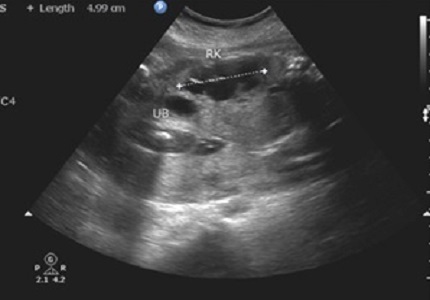Role of ultrasound in diagnosis of fetal congenital abdominal anomalies: One year prospective study
Abstract
Introduction: Congenital anomalies are important cause of perinatal and infant mortality, and are contributor to childhood morbidity. Fetal congenital abdominal anomalies are one of the most common anomalies. Ultrasound screening of fetus helps to identify these anomalies as early as possible in antenatal period and thus provides information for proper decisions during pregnancy.
Aim: To find out the incidence of congenital abdominal anomalies affecting fetus and to study the outcome in patients with fetal congenital abdominal anomalies by following them postnatally.
Material and Methods: Prospective, Observational and Non-interventional study. Ultrasound screening of 5761 fetuses were performed. Pregnancies, with ultrasound findings of fetal congenital abdominal anomalies with or without other associated anomalies, were followed up. Postnatal confirmation of anomalies were carried out by clinical examination/ imaging procedures / autopsy.
Results: Incidence of fetal congenital abdominal anomalies was 5.56 per 1000 births. Among the fetal congenital abdominal anomalies, fetal urinary tract anomalies were the most common with an incidence of 4.69 per 1000 births. Incidence of Omphalocele, Gastroschisis and Jejunoileal atresia were 5.2, 1.7 and 1.7 per 10,000 births respectively. Concordance between antenatal and postnatal diagnosis was 90.63%.
Conclusion: Antenatal ultrasound examination should be performed for all pregnant women to diagnose congenital anomalies. Prenatal diagnosis of congenital anomalies provides information for proper decisions during pregnancy, fetal intervention if available and appropriate treatment perinatally, thus improves perinatal and long term outcomes.
Downloads
References
Patel ZM, Adhia RA. Birth defects surveillance study. Indian J Pediatr. 2005 Jun;72(6):489-91.
Bhat BV, Ravikumara M. Perinatal mortality in India-Need for introspection. Indian J Matern Child Health. 1996; 7:31-3.
Agarwal SS, Singh U, Singh PS, Singh SS, Das V, Sharma A, Mehra P, Chandravati, Malik GK, Misra PK. Prevalence & spectrum of congenital malformations in a prospective study at a teaching hospital. Indian J Med Res. 1991 Dec;94:413-9.
Sarkar S, Patra C, Dasgupta MK, Nayek K, Karmakar PR. Prevalence of congenital anomalies in neonates and associated risk factors in a tertiary care hospital in eastern India. J Clin Neonatol. 2013 Jul;2(3):131-4. doi: https://dx.doi.org/10.4103%2F2249-4847.119998.
Wilson RD: SOGC genetics committee; special contributor. Prenatal screening, diagnosis, and pregnancy management of fetal neural tube defects. J Obstet Gynaecol Can. 2014 Oct;36(10):927-939. doi: https://doi.org/10.1016/S1701-2163(15)30444-8.
Grigore M, Iliev G, Gafiteanu D, Cojocaru C. The fetal abdominal wall defects using 2D and 3D ultrasound. Pictorial essay. Med Ultrason 2012;14(4):341-47.
Grandjean H, Larroque D, Levi S. The performance of routine ultrasonographic screening of pregnancies in the Eurofetus Study. Am J Obstet Gynecol. 1999 Aug;181(2):446-54.
Saha A, Batra P, Chaturvedi P, Mehra B, Tayade A. Antenatal Detection of Renal Malformations. Indian Pediatrics2008;46:346-48.
Kim EK, Song TB. A study on fetal urinary tract anomaly: antenatal ultrasonographic diagnosis and postnatal follow-up. J Obstet Gynaecol Res. 1996 Dec;22(6):569-73.
De La Vega A, Torres E. Prenatal diagnosis of renal disease. P R Health Sci J. 2005 Jun;24(2):141-4.
Bondagji NS. Antenatal diagnosis, prevalence and outcome of congenital anomalies of the kidney and urinary tract in Saudi Arabia. Urology Annals. 2014 Jan-Mar; 6(1):36-40. doi: https://dx.doi.org/10.4103%2F0974-7796.127021.
Kumar M, Thakur S, Puri A, Shukla S, Sharma S, Perumal V, Chawla R, Gupta U. Fetal renal anomaly: factors that predict survival. J Pediatr Urol. 2014 Dec;10(6):1001-7. doi: https://doi.org/10.1016/j.jpurol.2014.11.007. Epub 2014 Nov 12.
Sanghvi KP, Merchant RH, Gondhalekar A, Lulla CP, Mehta AA, Mehta KP. Antenatal diagnosis of congenital renal malformations using ultrasound. J Trop Pediatr. 1998 Aug;44(4):235-40.
Brunisholz Y, Vial Y, Brignon CM, Meyrat BJ, Frey P, Hohlfeld P. Prenatal diagnosis of urinary malformations: results in a series of 93 consecutive cases. Swiss Med Wkly. 2001 Feb 24; 131(7-8):95-8.
Policiano C, Djokovic D, Carvalho R, Monteiro C, Melo MA, Graça LM. Ultrasound antenatal detection of urinary tract anomalies in the last decade: outcome and prognosis. J Matern Fetal Neonatal Med. 2015 May; 28(8):959-63. doi: https://doi.org/10.3109/14767058.2014.939065.
Helin I, Persson PH. Prenatal diagnosis of urinary tract abnormalities by ultrasound. Pediatrics. 1986 Nov;78(5):879-83.
Barakat AJ, Butler MG, Cobb CG, Coursey JW, Shah D. Reliability of ultrasound in the prenatal diagnosis of urinary tract abnormalities. Pediatr Nephrol. 1991 Jan;5(1):12-4.



 OAI - Open Archives Initiative
OAI - Open Archives Initiative


